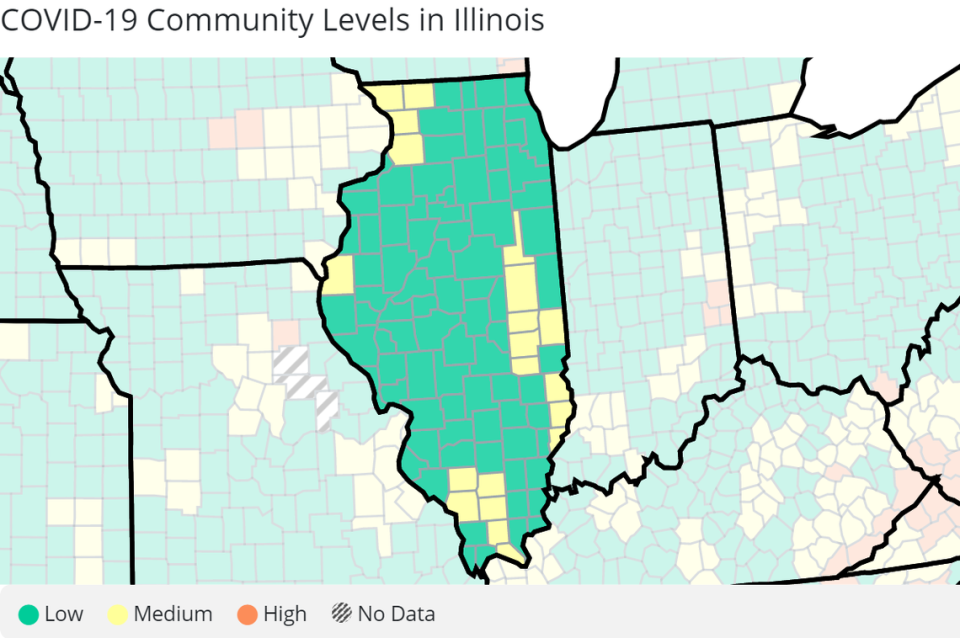Three years after Illinois’ first COVID-19 case, state has reported 36,091 deaths
- Oops!Something went wrong.Please try again later.
COVID-19 spread has recently declined throughout Illinois, as the U.S. Centers for Disease Control and Prevention rated none of the state’s counties at high COVID-19 community levels in the Thursday update.
The CDC rated 20 Illinois counties at medium, down from 25 medium counties last week. The previous week saw three counties at high levels.
Medium level counties in Illinois include Perry, Jackson, Franklin, Williamson, Johnson and others. St. Louis City and St. Louis County are both at medium levels, as well.
Although no state counties are currently at high, Illinois has reported more than 4 million COVID-19 cases since January 2020.
Illinois Department of Public Health officials recently announced the three-year anniversary of the first COVID-19 case reported in the Land of Lincoln, which took place Jan. 24, 2020. IDPH has recorded 4,019,768 cases and 36,091 deaths across the state since the initial infection.
For the week ending Jan. 22, IDPH reported 10,924 new confirmed and probable COVID-19 cases and 86 deaths.
The CDC’s COVID-19 community levels are updated Thursdays and based on metrics from the past seven days, including new hospital admissions per 100,000 people, average percent of staffed, inpatient beds occupied by COVID patients and new cases per 100,000 people.
People in high community level areas are advised to wear a mask indoors and on public transportation, and the federal agency says people at a higher risk of severe illness should consider precautions in medium-level areas.

IDPH Director Dr. Sameer Vohra wrote in a Jan. 27 statement the state and region are seeing a gradual increase of XBB.1.5 “Kraken” variant.
“It is good news that COVID-19 community levels are continuing to decline in Illinois, with no counties listed at high level,” Vohra said in the statement. “We are seeing a gradual increase in the rate of the XBB.1.5 ‘Kraken’ variant in the Midwest and Illinois compared to last week. At this moment, it is not leading to an increase in hospitalizations. Concerns remain about this variant, but new data released by the CDC shows that the updated bivalent COVID-19 booster is protective against it – reducing the risk of symptoms by nearly half. We ask Illinoisians to remain vigilant and use readily available tools like vaccines and antiviral treatments to avoid hospitalizations and protect the most vulnerable.”
Medications may be available for some patients who test positive for COVID-19, and test to treat locations can be found online.
COVID-19 in St. Clair County, statewide
IDPH reports St. Clair County’s weekly case rate is 70.5 per 100,000 people as of Jan. 27, down from 77 last week. The portion of available intensive care unit beds has remained at 22% week-to-week.
The seven-day rolling number of hospital admissions is two, and IDPH reported three COVID-19 deaths in St. Clair County.
The CDC reports St. Clair County’s weekly case rate at 70.85 per 100,000 people. There were 5.2 new COVID-19 hospital admissions per 100,000 people there, according to the CDC, and 3.8% of the county’s staffed inpatient beds are in use by COVID-19 patients.
St. Clair County’s weekly case rate has declined by 8.46% as of Jan. 25, the CDC reports, and test positivity is at 4.66%. The rate of tests performed has dropped by 14.41% as of Jan. 19.
IDPH reports the statewide weekly case rate is 85.7 per 100,000 individuals, down slightly from 86.1 last week. ICU availability is at 20% in Illinois, and the state’s seven-day rolling number of hospital admissions is 90.
As of Thursday night, IDPH reported 999 individuals in Illinois were hospitalized with COVID-19, including 117 ICU patients and 45 people on ventilators. Illinois health officials reported 86 weekly COVID-19 deaths.
Future of COVID-19 vaccines
U.S. Food and Drug Administration officials have proposed an annual COVID-19 vaccine with potentially twice a year shots for those who are at a higher risk.
The shift “would also eliminate the two-shot primary series for most unvaccinated people,” ABC News reported.
In a Dec. 16 statement, the FDA said COVID-19 vaccination remains the best available protection, particularly against severe outcomes such as hospitalization and death.
“Since the initial authorizations of these vaccines, we have learned that protection wanes over time, especially as the virus rapidly mutates and new variants and subvariants emerge,” FDA officials said. “Therefore, it’s important to continue discussions about the optimal composition of COVID-19 vaccines for primary and booster vaccination, as well as the optimal interval for booster vaccination.”
Despite data showing bivalent booster vaccines provide additional protection against symptomatic XBB/XBB.1.5 infection, less than 20% of Illinoisans have opted for the shot so far, according to the CDC.
St. Clair County has an even lower bivalent booster vaccination rate at under 15% as of Jan. 18.
Here are bivalent booster vaccination rates for the rest of the state:
Note: This graphic will automatically update as new data become available.
Vaccination and testing information is available online in St. Clair County.
Note: Some CDC data, such as test positivity rates, the number of tests performed and weekly case rate, update on different days. IDPH data and CDC data may not update at the same time, so metrics may vary across agencies.

